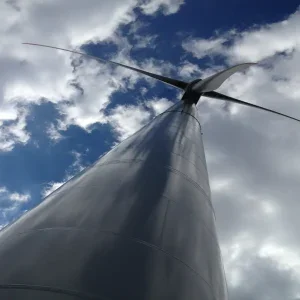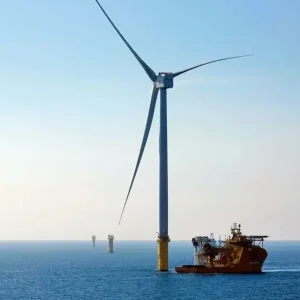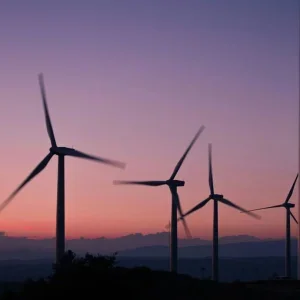Sir David King, the UK’s climate change chief negotiator for the past 17 years, has defined climate change as a key factor in creating demand for clean energy and so increasing the share of the world’s wind-power generation in the global energy mix.
He has set high post-Paris standards for his successor, Nick Bridge, who was previously UK ambassador to the OECD. King’s climate strategy, which shaped the Paris climate change agreement in 2015, will serve as a long-term template for how to implement existing agreements while leveraging the role of renewables and nuclear power. He has also set the long-term parameters of the UK and global direction of climate change management, notably in science and policy.
“The Paris target is low, so we will need to improve it”, otherwise the temperature will increase by 4–5°C due to climate change and will go above the Paris target of a 2°C increase by 2020, according to King.
The greatest scientific challenge facing the world is the need for clean energy that costs less than fossil fuels, according to an academic paper authored by King and fellow researchers from the London School of Economics. Despite the challenge, the report says that “only 2% of the world’s research and development (R&D) now goes on the problem” of climate change.
We have shifted away from coal to focus on offshore wind and become the leader in offshore wind technology,” King says. Globally, renewable power expanded at its fastest-ever rate in 2015, thanks to supportive government policies and sharp cost reductions that accounted for more than half of the world’s additional electricity capacity, according to the International Energy Agency. Yet, even with this remarkable progress, there are questions about whether renewables are on track to reach targets set by the Paris agreement.
The growth of wind-power generation as a share of all electricity generation has also seen a significant expansion of the opportunities in the global wind operations and maintenance (O&M) market. This market has seen its value increase from just over $13.7 billion in 2016 to around $27.4 billion by 2025, representing a compound annual growth rate of 8%, according to GlobalData research from June 2017. Maintenance of existing wind farms is a key driver to growth in global wind power and is essential as it contributes to value creation, increases turbine availability, and improves returns. This trend is a result of aging wind turbines and the failure of components such as blades and gearboxes.
Technical advancement
In addition, the share of the offshore wind-power operations market is expected to grow globally from 8.0% in 2016 to 18.4% by 2025. The offshore market has been pushed up by new technologies due to its high yield, its stronger and more consistent winds in comparison with onshore, and the scope to construct massive gigawattscale projects.
So, new technologies will continue to underpin wind-power growth. Offshore wind attracts higher operational costs than onshore wind generation due to factors such as more expensive turbine maintenance, logistics and a lack of skilled labour. Currently, China represents the largest wind maintenance market with a 30% share but this is expected to fall to 27.4% in 2025. However, a large installation base, government plans and strict environmental laws are the major drivers for the growth of the Chinese market. The US follows China with 14.6% market share in 2016 and is likely to maintain its position by 2025 while Germany, the largest European wind-power maintenance market, accounted for 14.3% this may fall to 11.9% in 2025.
The major reason for key countries such as Germany losing their market share is the emergence of newer markets, such as India and the UK. India’s share of the global wind operations market is expected to increase from 5.6% in 2016 to 6.4% in 2025, while the UK’s share will increase from 5.3 to 7.1% over the same period.
However, this level of revenue from wind-power generation, and a technological revolution in wind turbine design and maintenance, did not come without a political fight across the globe. King was the UK’s permanent special representative for climate change from September 2013 until March 2017 and was also the country’s chief scientific adviser from 2000 to 2007. During this time, he was also one of the founders of the UK’s Energy Technologies Institute.
The EU was the first major economy to submit its intended contribution to the Paris agreement in March 2015. It is already taking steps to implement its target of reducing emissions by at least 40% by 2030. For the agreement to come into force, it had to be ratified by at least 55 countries, representing a minimum of 55% of global emissions. In October 2016, the EU formally ratified the Paris agreement and enabled it to come into force in November 2016.
According to King, “We can manage climate change only through global agreements [despite our previous history in the field].” He adds, “Former UK Prime Minister Tony Blair put climate change as our number one foreign policy agenda for the first time, as it is good for countries to be able to challenge each other, as we did with Brazil’s deforestation.”
In December 2015, 195 countries adopted the first-ever universal, legally binding global climate deal, followed by ongoing country-bycountry ratification. The agreement sets out an action plan to put the world on track to avoid dangerous climate change by limiting global warming to well below 2°C and serves as a bridge between today’s policies and climate neutrality before the end of the century.
Renewables mix
The EU’s emissions trading scheme (ETS) plays a key part in ensuring the UK complies with its legally binding carbon budgets, which will in turn help the country reduce its emissions to at least 35% below 1990 levels in 2020, and 80% by 2050. These targets are set out in the UK’s Climate Change Act 2008.
However, the parliamentary Business, Energy and Industrial Strategy (BEIS) Committee has recently warned that the UK is behind its target to make renewables 15% of its energy mix by 2020. The ETS pushes clean energy, such as wind power, because paying for greenhouse emissions is expensive. According to the BEIS, if the UK misses its 2020 renewable energy targets as part of the EU, it will undermine confidence in the UK Government’s commitment to clean energy and the climate targets agreed in Paris.
King says: “In the UK, we have reduced our emissions by 42%, while the level for the EU is at least 48% by 2030, and these targets have been a joint effort. Our key challenge today is the misunderstanding of the severity of risk if we do not comply with the current emissions targets. Climate change creates a great opportunity for clean energy infrastructure, [and] a lot of it is already serving renewables. Meanwhile, the EU has already created a market for renewables, so their production price has fallen and makes them competitive with fossil fuels. Clearly, by using clean energy we reduce pollution, but we have to end fossil fuel use.”
King notes that Mark Carney, the governor of the Bank of England, has said that the next financial crisis will come from not eliminating fossil fuels. “22 countries now invest in clean energy and are expected to spend £30 billion [$38.4 billion] by 2020, however public spending on research and support for new technologies is paramount,” King says. As a result, current public investment in renewable energy R&D is not commensurate with the gravity of the threat to the environment and is not coordinated. An LSE report says the field “has been starved”, with just $6 billion a year currently spent on renewable energy R&D, compared with annual subsidies to fossil fuel industries that total around $550 billion.
However, countries like France may lead the way in the mid-term, despite the UK’s expertise in climate change finance. This is especially the case given some of the green energy pledges of newly elected French President Emanuel Macron. He has put forward bullish renewable energy objectives that aim to cut the share of nuclear power in France from 75% to 50% by 2025, as set out in French law in 2015. This would lead to the closure of an estimated 25GW of nuclear power capacity by 2025. However, achieving this reduction while maintaining grid stability will be challenging. “Nuclear power is commercially available and you get a lot [of power] out of Europe’s 1.6GW of nuclear capacity,” says King.
“The big question is how to make the most successful cost crossover point between renewable and nuclear power,” he continues. “Nuclear energy had a place in many countries, outside seismic countries, so the biggest danger is climate change, not nuclear power.”






